DPA d:screet 4071 Handleiding
Bekijk gratis de handleiding van DPA d:screet 4071 (9 pagina’s), behorend tot de categorie Microfoon. Deze gids werd als nuttig beoordeeld door 55 mensen en kreeg gemiddeld 4.3 sterren uit 28 reviews. Heb je een vraag over DPA d:screet 4071 of wil je andere gebruikers van dit product iets vragen? Stel een vraag
Pagina 1/9

Introduction
To ensure optimal performance of your
DPA Miniature Microphone, please follow
the simple care and maintenance instruc-
tions below.
Miniature Microphones from DPA are
designed to be very resistant to humidity,
moisture and sweat. Highly resistant mate-
rials like gold plated stainless steel, and fea-
tures like the double-vent-protection-sys-
tem are used in construction of the micro-
phones, to avoid damage by hostile fluids. In
any case, it is still a good idea to keep the
Miniature Microphones away from any kind
of unnecessary exposure to water and
cleaning fluids and to keep the microphone
element dry at all times.
1. Cleaning guide
The cable and protection grid are the only
parts that may be cleaned if necessary.
The protection grid is permanently fixed
and protects the microphone element
inside. Do not attempt to remove the pro-
tection grid under any circumstances.
Do not use any kind of cleaning fluid other
than distilled water. Use of ultra-sonic baths
must be avoided. Avoid all kinds of spray or
fluids, which contain chemical components
to remove static electricity on or close to
the microphone as this could cause dam-
age to the electret layer.
When mounting the Miniature Microphone
directly on the skin of a performer, care
should be taken to avoid sweat from run-
ning directly into the microphone. If the
microphone gets filled up with water or
sweat it will not be damaged, but possibly
turn deaf while the water is captured inside
the microphone, behind the protection grid.
Remove the water by shaking the micro-
phone or drying it with a piece of lint free
cloth.
Note: If the microphone has been
exposed to water or sweat it must be
left to dry out to recover its original
specifications. Drying out the
Miniature Microphone between expo-
sures to humidity will also help to
extend its lifetime. Leaving the micro-
phone with the power on will speed up
the drying process, as the built-in pre-
amplifier will gently heat up the micro-
phone (idle power ~2 mW).
Tip: In order to save battery power on the
belt pack transmitters while drying out the
microphone, it is a good idea to use a P48
Phantom Power Adapter (DAD6001).
1.1 Cleaning the microphone grid
During use in environments where the
microphone is exposed to make-up or dusty
materials, the grid may get clogged up. If
needed, clean the grid using a sof t cloth
and distilled water only.
1
MANUAL 4071 -2 13/05/03 9:21 Side 1

32
2.3 Correct treatment of the micro-
phone cable
The cable is usually longer than required for
its actual purpose. Ensure that superfluous
cable is wound up in soft loops (preferably
6-8 cm in diameter). Avoid ’kinks’ in the
cable. Exposing the cable to stretching
beyond its specifications or stressing it by
winding it tightly over sharp edges will
reduce the microphone’s operational life
Tip: Handling noise from the cable can be
decreased by up to 30dB by making a loose
loop in the cable, as close to the micro-
phone element as possible. The DMM0008
Miniature Clip, double lock, is designed for
this mounting technique.
Tip: The place where the cable enters the
MicroDot connector will sometimes be
exposed to excessive stress and after long
term heavy-duty use, the cable might show
signs of wear at this point. As a preventive
maintenance procedure, it may be advis-
able to replace the connector in this
instance. Contact the nearest DPA
Microphones representative for mainte-
nance advice or assistance.
2.4 Correct use of adapters and
MicroDot connectors
To provide users with safe and compact
mounting of connectors, all Miniature
Microphones from DPA are fitted with the
MicroDot connector as standard. A broad
Correct way to wind up the cable
of the Miniature Microphone.
Please note t he slack after the connector.
A connector tightening tool is
supplied with each adapter
1.2 Cleaning the microphone cable
Residue from tape, glue or make-up on the
cable must be removed after use. Leaving
these substances on the cable over longer
periods of time may etch into the cable
jacket and will make the cable more suscep-
tible to breaks. The cable can easily be
cleaned using organic oil (e.g. olive oil) or
lukewarm, distilled water.
Do not bend the cable or rub it harshly
since this may stress the inner cores of the
cable and cause them to break over time.
2. Correct use of the Miniature
Microphone
It is important to observe the following
guidelines concerning the daily use of the
microphone.
2.1 Description of presence boost and
frequency response
The type 4071 has a fixed microphone grid
with a typical 5dB soft boost at 4-6kHz.
This so-called “presence area” is the range
where the human ear is most sensitive and
is also the range of speech intelligibility, clar-
ity and definition. When a microphone is
placed on the chest for example, clarity
seems to be lost. Most engineers will com-
pensate for this by having a presence
boost on an equalizer in the following audio
path, to make the voice “cut through”.
The Type 4071 with presence boost will
make use easier and quicker and will intro-
duce less noise and distortion than any EQ
will because the boost is done acoustically, at
the microphone diaphragm. An acoustic lo-
cut has been incorporated in the capsule so
the built-in preamp and the perhaps follow-
ing wireless system will have much larger
headroom. When recording voices, from
microphone placement on the performer’s
body, no frequency below 100 Hz is relevant.
For this reason, the airing vent in the capsule
has been specially designed to make the fre-
quency response 2dB attenuated at 100Hz,
with a 3dB per octave roll off. Outdoor
recordings can introduce unwanted wind
rumble. The lo-cut feature will reduce the low
frequency part of the wind rumble.
2.2 Correct treatment of the micro-
phone element
The diaphragm in the microphone element
is the most sensitive part of the unit and as
emphasized earlier, it must be left
untouched to preserve its original charac-
teristics. Do not spray any substances such
as hair spray directly into the microphone
and avoid getting make-up or paint on the
microphone element and housing.
Tip: In lapel or tie placement it is recommend-
ed that the microphone grid point away from
the mouth to decrease breathing noises
caused by the mouth or nose of the per-
former. The microphone element is com-
pletely omnidirectional at all frequencies, so
this method will not colour the sound.
MANUAL 4071 -2 13/05/03 9:21 Side 2

54
EMK 407 1 ENG/E FP MI CROPH ON E KI T
Also available as DAK4071-E excluding microphone and adaptor.
DAD6024 XLR adaptor wit h mid range
attenuation
3. EMK4071 ENG/EFP Microphone Kit
This kit is made for ENG/EFP use, when the
microphone is allowed to be visible. The kit
is delivered in a sturdy, hard case with a
transparent lid. It contains a 4071-BM
Miniature Microphone and the following
accessories:
Adaptor: MicroDot to 3-pin. XLR (P48)w.
Mid Range Attenuation (DAD6024)
Designed for microphone placement on the
human body. When placing a microphone on
a performer’s chest, an acoustic lower
midrange boost will occur resulting in a
"muddy" and indistinct sound, compared to a
free frontal placement. This adapter pro-
vides a 3dB attenuation at 800Hz for added
clarity when using a Miniature Microphone.
range of connection adapters is offered as
optional accessories for most VHF and UHF
systems for professional use. The adapters
are ultra-compact and will in most cases
take up no more space than the original
connectors. With each adapter comes a
connector-tightening tool, which should be
employed whenever the MicroDot connec-
tor needs to be tightened safely onto t he
adapter for long periods of time.
Never attempt to loosen or tighten the con-
nector by the cable or its strain relief.
Despite the use of Kevlar, the cable might
be damaged if twisted with excessive
force. Tighten the MicroDot using finger
torque or the recommended tightening tool
only. Do not use glue.
Do not mount any other connector onto
the cable than the standard MicroDot con-
nector from DPA Microphones. The DPA
MicroDot connector is specially designed
for use with the Kevlar reinforced cable,
ensuring the maximum possible tensile
strength in the design. In case of failure,
MicroDot spare parts, assembly tool and
assembly guide can be acquired.
Various wireless systems require the use of
electronic components inside the adapter to
optimize the signal level, the DC-offset filter-
ing and powering of the built-in microphone
preamplifier. Using the adapters from DPA
ensures the correct electronic circuit with
the listed types of wireless systems at all
times. Do not attempt to employ non-stan-
dard adapters or connectors as you might
damage the microphone preamplifier.
MANUAL 4071 -2 13/05/03 9:21 Side 4
Product specificaties
| Merk: | DPA |
| Categorie: | Microfoon |
| Model: | d:screet 4071 |
Heb je hulp nodig?
Als je hulp nodig hebt met DPA d:screet 4071 stel dan hieronder een vraag en andere gebruikers zullen je antwoorden
Handleiding Microfoon DPA
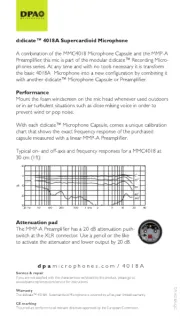
13 April 2025

13 April 2025
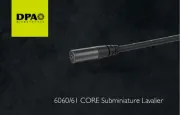
11 April 2025
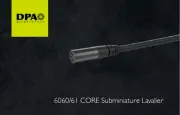
11 April 2025

8 December 2024

23 Juni 2024

23 Juni 2024

21 Juni 2024

11 Juni 2024

11 Juni 2024
Handleiding Microfoon
- King Lucky
- Fluid
- Louroe Electronics
- IMG Stage Line
- Dimavery
- Ponovo
- LAMSCAT
- Bogen
- IC Intracom
- Palmer
- Intricon
- Natec
- DOCKIN
- Sytech
- JOBY
Nieuwste handleidingen voor Microfoon

15 September 2025

15 September 2025
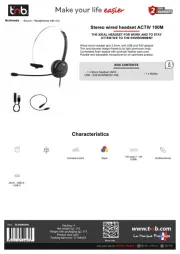
15 September 2025

15 September 2025
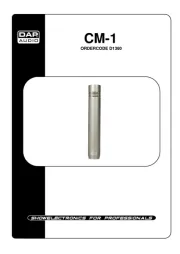
15 September 2025

13 September 2025

12 September 2025

12 September 2025
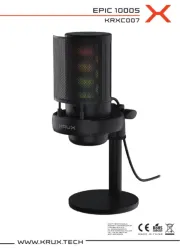
12 September 2025
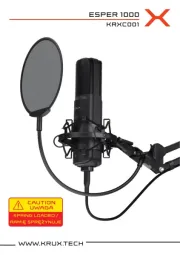
12 September 2025